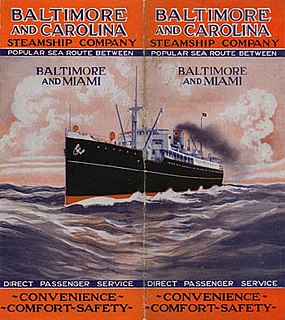
USS Lackawanna (AO-40) was a Kennebec-class type T2 fleet oiler of the United States Navy. The ship was laid down 27 December 1941, as SS Conastoga, by the Bethlehem-Sparrows Point Shipyard Inc., Sparrows Point, Maryland, under Maritime Commission contract number 147. Launched on 16 May 1942, sponsored by Mrs. S. J. Dickey, acquired by the Navy on 20 June 1942, and commissioned on 10 July 1942 at Baltimore, Lt. Comdr. S. R. Sands, Jr., USCG, in command.

USS Adair (APA-91) was a Windsor-class attack transport in service with the United States Navy from 1944 to 1946. She was sold to commercial service in 1947 and was finally scrapped in 1970.

The Type C4-class ship were the largest cargo ships built by the United States Maritime Commission (MARCOM) during World War II. The design was originally developed for the American-Hawaiian Lines in 1941, but in late 1941 the plans were taken over by the MARCOM.
SS Sachem may refer to one of two Type T3-S-A1 tankers built for the United States Maritime Commission by Bethlehem Sparrows Point Shipyard:
SS Samoset may refer to one of two Type T3-S-A1 tankers built for the United States Maritime Commission by Bethlehem Sparrows Point Shipyard:
SS Shabonee may refer to one of two Type T3-S-A1 tankers built for the United States Maritime Commission by Bethlehem Sparrows Point Shipyard:
SS or MS Mormacpenn may refer to one of several Type C3 ships built for the United States Maritime Commission on behalf of Moore-McCormack Lines:
SS Deltargentino may refer to one of two Type C3-P&C ships built for the United States Maritime Commission by Bethlehem Sparrows Point Shipyard and intended for the Mississippi Shipping Company:
SS Delorleans may refer to one of two Type C3-P&C ships built for the United States Maritime Commission by Bethlehem Sparrows Point Shipyard and intended for the Mississippi Shipping Company:
SS Mormacmail may refer to one of several Type C3 ships built for the United States Maritime Commission on behalf of Moore-McCormack Lines:
SS Exporter may refer to one of these ships built for or owned by American Export Lines:
SS Exford may refer to one of several ships of American Export Lines:
SS Executor may refer to one of these ships built for or owned by American Export Lines:
SS Corsicana may refer to one of two Type T2 tankers built for the United States Maritime Commission:
SS Conastoga may refer to one of three Type T2 tankers built for the United States Maritime Commission during World War II:
SS Caddo may refer to one of two Type T2 tankers built for the United States Maritime Commission for the Socony-Vacuum Oil Company:
SS Richard Bassett was a Liberty ship built in the United States during World War II. She was named after Richard Bassett, a Delaware attorney and politician, veteran of the American Revolutionary War, delegate to the Constitutional Convention of 1787, signer of the United States Constitution, United States Senator from Delaware, Chief Justice of the Delaware Court of Common Pleas, Governor of Delaware and a United States Circuit Judge of the United States Circuit Court for the Third Circuit. He holds the overall seniority position of #1 in the history of the United States Senate.
SS Tristram Dalton was a Liberty ship built in the United States during World War II. She was named after Tristram Dalton, an American politician and merchant from Massachusetts. He served a single term as one of the first United States senators, from 1789 to 1791.

A. H. Bull Steamship Company was a shipping company and passenger liner service founded in New York City in 1902 by Archibald H. Bull (1848-1920). Service started with shipping between New York and Florida. His fleet of ships then added service to other Eastcoast ports. The company is also often called the Bull Lines and the Bull Steamship Line or A. H. Bull & Company. While founded in New York, Bull soon move its headquarter to Peir 5 in Baltimore, Maryland. Bull Lines main Eastcoast ports were: Baltimore, Charleston, Philadelphia, Tampa and Norfolk, Virginia. Oversea ports: Porto Rico, Antwerp, Bordeaux, Hamburg, Bremen, Copenhagen, and West Africa. Bull Steamship Line supported the US war effort for both World War I and World War II, including the loss of ships.

Bethlehem Key Highway Shipyard started as William Skinner & Sons in downtown Baltimore, Maryland in 1815. In 1899 the shipyard was renamed Skinner Shipbuilding & Dry Dock Company. Also at the site was Malster & Reanie started in 1870 by William T. Malster (1843–1907). In 1879 Malster partnered with William B. Reaney (1808-1883). In 1880 Malster & Reanie was sold and renamed Columbian Iron Works & Dry Dock Company. Malster & Reanie and Skinner Shipbuilding & Dry Dock Company merged in 1906, but remained as Skinner Shipbuilding. In 1914 the company was renamed Baltimore Dry Dock & Shipbuilding Company. Baltimore Dry Dock & Shipbuilding Company sold to Bethlehem Steel in 1922, becoming part of Bethlehem Shipbuilding Corporation. Bethlehem Steel operated the shipyard for ship repair, conversion and some ship construction. Bethlehem main ship construction site was across the harbor at Bethlehem Sparrows Point. Bethlehem Key Highway Shipyard was known as the Bethlehem Upper Yard located north-east side of Federal Hill. Bethlehem Fort McHenry Shipyard located on the west side of Locust Point peninsula was known as the Lower Yard, near Fort McHenry.
This page is based on this
Wikipedia article Text is available under the
CC BY-SA 4.0 license; additional terms may apply.
Images, videos and audio are available under their respective licenses.




